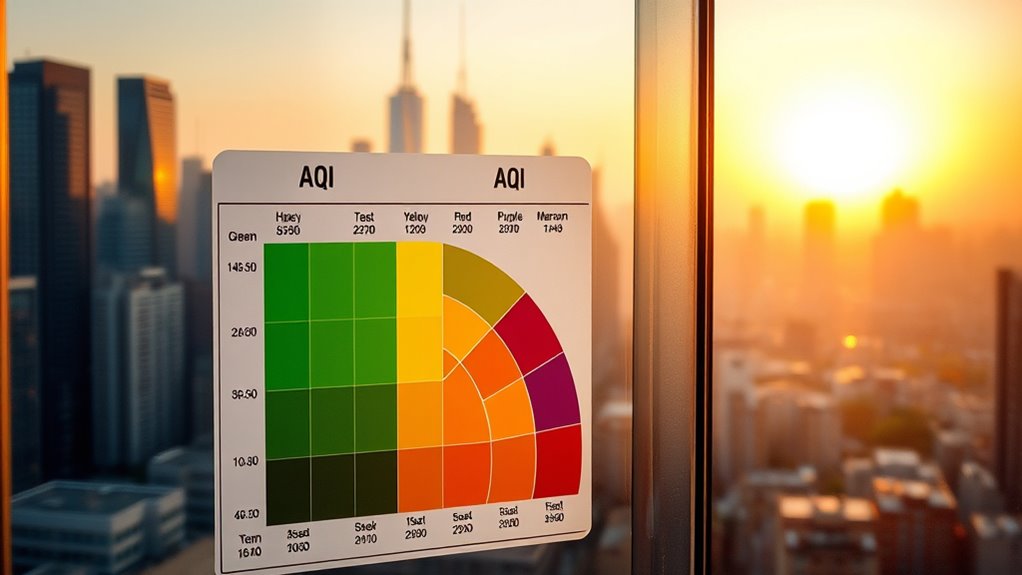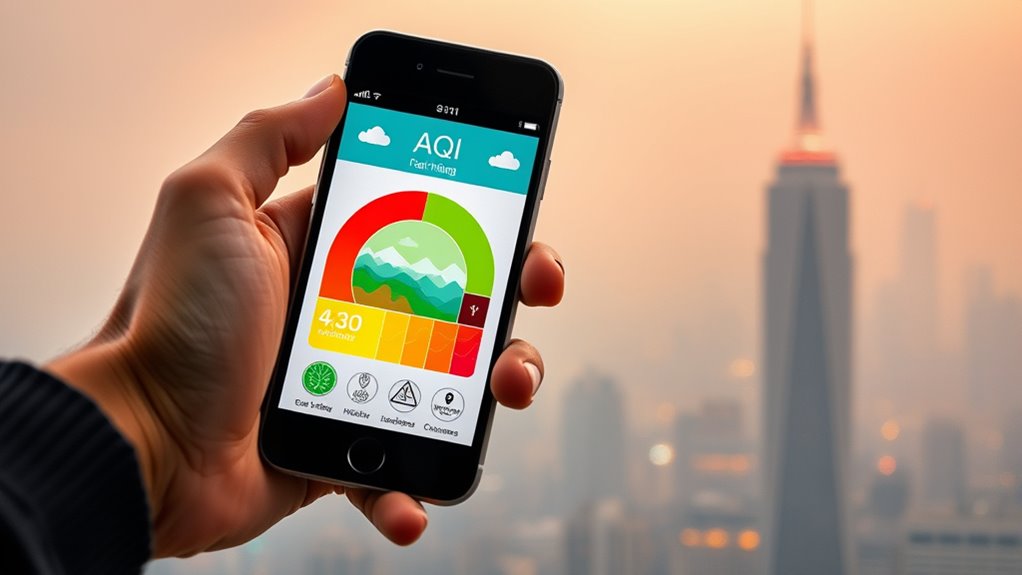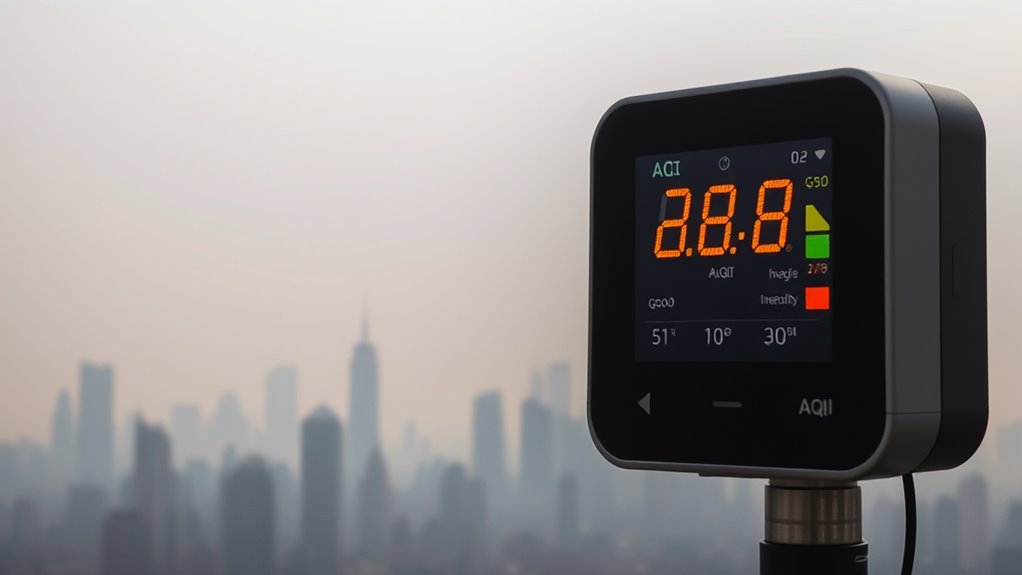To interpret AQI readings, first note the numerical value and corresponding color code. Lower numbers (0-50, green) mean good air quality, while higher numbers (above 150, red or purple) indicate unhealthy levels. Pay attention to the specific category—moderate, unhealthy, or hazardous—and consider health risks. If the AQI is high, take precautions like staying indoors or wearing a mask. Keep reading to discover how these levels impact your health and safety.
Key Takeaways
- Check the AQI value to determine air quality: 0-50 (Good), 51-100 (Moderate), higher indicates increasing pollution levels.
- Match the AQI number with its category and color code for quick understanding of health implications.
- Understand that higher AQI levels (orange to maroon) signal greater health risks, especially for sensitive groups.
- Use AQI updates to decide on outdoor activities, wearing masks, or taking protective measures during high pollution.
- Regularly monitor AQI trends to assess pollution changes and adjust your exposure and safety actions accordingly.
What Is the Air Quality Index (AQI)?

Have you ever wondered how authorities determine whether the air is safe to breathe? The Air Quality Index (AQI) is a tool that makes this possible. It assesses air pollution sources like vehicle emissions, industrial activities, and natural events that affect air quality. The AQI converts complex pollution data into a simple scale, making it easier for you to understand how clean or polluted the air is. It’s based on air quality standards set by health organizations, which specify safe limits for pollutants such as ozone, particulate matter, and carbon monoxide. When the AQI is high, it indicates poor air quality, while a low AQI suggests cleaner air. This index helps you make informed decisions about outdoor activities and health precautions. Additionally, the AQI accounts for various pollutants’ health impact, providing a comprehensive overview of air safety.
Understanding AQI Categories and Color Codes

Ever wonder what the different AQI categories and color codes mean? They help you quickly understand air quality levels and potential health impacts. The AQI is divided into categories like “Good,” “Moderate,” “Unhealthy for Sensitive Groups,” “Unhealthy,” “Very Unhealthy,” and “Hazardous.” Each category has a specific color code—green for good, yellow for moderate, orange for unhealthy for sensitive groups, red for unhealthy, purple for very unhealthy, and maroon for hazardous. Pollution sources such as vehicle emissions, industrial activities, and outdoor burns influence these levels. When outdoor activities are planned, understanding these categories helps you decide whether to go ahead or take precautions. The color codes provide an immediate visual cue about air quality, so you can protect yourself and your loved ones accordingly. Monitoring methods are essential for accurately assessing air quality levels and determining appropriate responses.
How AQI Levels Affect Health and Safety

Since AQI levels directly reflect the concentration of pollutants in the air, they considerably impact your health and safety. High AQI readings indicate increased pollution sources like vehicle emissions, industrial processes, and wildfires, which pose serious health implications. When AQI reaches unhealthy levels, you risk respiratory issues, aggravation of asthma, and other cardiovascular problems. To stay safe:
- Avoid outdoor activities during high pollution periods.
- Keep windows closed to limit indoor pollution.
- Use air purifiers if available to reduce pollutant exposure.
Effective air quality monitoring enables timely responses to changing conditions, helping you protect your health more proactively.
Understanding these impacts helps you make informed decisions about exposure and protection. Recognizing how pollution sources influence AQI levels enables you to adapt your behavior and safeguard your health effectively. Staying aware of AQI readings is key to minimizing health risks associated with air pollution.
Practical Tips for Responding to AQI Readings

When AQI levels rise to unhealthy ranges, taking immediate and effective actions can protect your health. Start by improving indoor air quality through air purification devices, such as HEPA filters, to reduce airborne pollutants. Keep windows and doors closed to prevent outdoor air from entering your home. Wearing personal protective equipment like masks can also help reduce inhalation of harmful particles, especially if you need to go outside. Avoid strenuous outdoor activities during high AQI days, and consider relocating to a cleaner environment if possible. Regularly checking AQI updates enables you to respond promptly. Maintaining good indoor air quality and using protective gear are essential steps to minimize health risks when outdoor air quality deteriorates. Additionally, understanding the air quality index (AQI) can help you make informed decisions about outdoor activities and health precautions.
Monitoring and Staying Informed About Air Quality

Staying informed about air quality requires regularly monitoring AQI reports from reliable sources. You can do this through government websites, weather apps, or local news outlets that provide real-time updates. Using air quality sensors around your home also helps you track conditions proactively. To stay prepared, focus on these key points: 1. Keep an eye on daily AQI updates to understand current pollution levels. 2. Use apps or websites that compile data from multiple sensors for an all-encompassing view. 3. Promote public awareness by sharing accurate information with friends and family to protect vulnerable populations. Additionally, understanding how to interpret air quality indices can help you make informed decisions about outdoor activities.
Frequently Asked Questions
How Often Should I Check the AQI for My Area?
You should check the air quality monitoring regularly, especially if pollution levels tend to fluctuate in your area. During days with high pollution or smog, check the AQI more frequently, like daily or multiple times a day. If you have respiratory issues or outdoor activities planned, stay updated on the AQI to protect your health. Consistent monitoring helps you make informed decisions to reduce exposure to harmful air pollutants.
Are There Apps to Track Real-Time AQI Updates?
You can easily track real-time AQI updates using air quality monitoring through smartphone applications. These apps provide instant data, so you know when air quality improves or worsens. Simply download trusted apps like AirVisual, AQICN, or BreezoMeter, and enable notifications. This way, you stay informed about local air conditions and can take necessary precautions, especially on days with high pollution levels.
How Does Weather Influence AQI Levels?
In the age of the jet, weather plays a crucial role in AQI levels. You’ll notice that weather patterns like wind, temperature, and humidity influence pollution dispersion. Seasonal variations can cause higher AQI readings during winter due to trapped pollutants or in summer from increased ozone. You should stay informed about these weather factors because they directly impact air quality, helping you plan outdoor activities safely.
Can Indoor Air Quality Affect AQI Readings?
Indoor air quality can influence AQI readings, especially if indoor pollution levels are high. Poor ventilation strategies allow pollutants like dust, smoke, or VOCs to accumulate, which can skew readings if sensors are placed indoors. To get an accurate picture of outdoor air quality, guarantee good ventilation and minimize indoor pollution sources. Proper ventilation strategies help reduce indoor pollutants, but remember that AQI primarily reflects outdoor air conditions.
What Are the Long-Term Health Effects of Exposure to Poor AQI?
Long-term exposure to poor AQI can markedly impact your health. You might develop chronic respiratory issues like asthma or bronchitis, and your cardiovascular risks increase over time. Breathing polluted air regularly strains your lungs and heart, leading to lasting damage. To protect yourself, reduce outdoor activities during high AQI days and improve indoor air quality. Staying informed helps you make better choices for your health and well-being.
Conclusion
Knowing how to interpret AQI readings helps you protect your health and make informed decisions. Did you know that on days with poor air quality, asthma attacks can increase by up to 30%? By staying aware of AQI levels and following safety tips, you can reduce your risk and breathe easier. Keep monitoring the air quality regularly, so you’re always prepared to take action when needed. Your lungs will thank you!









